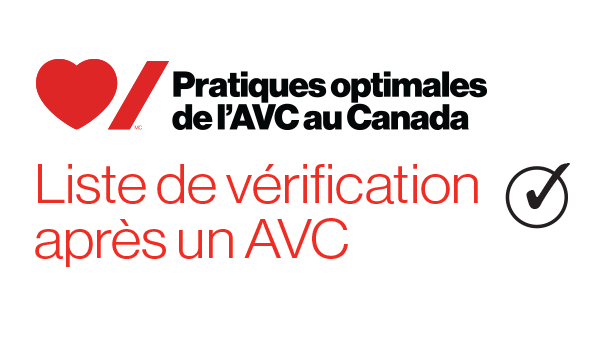- Définition et considérations
- 1. Évaluation initiale des besoins en matière de réadaptation post-AVC
- 2. Soins offerts dans les unités de réadaptation post-AVC
- 3. Prestation des soins de réadaptation post-AVC en milieu hospitalier
- 4. Réadaptation à domicile et en consultation externe post-AVC (y compris le congé précoce assisté)
- 5.1 Prise en charge des membres supérieurs après un AVC : principes généraux et traitements
- 5.2 Amplitude du mouvement et spasticité de l’épaule, du bras et de la main
- 5.3 Prise en charge de la douleur à l’épaule et du syndrome douloureux régional complexe (SDRC) après un AVC
- 6.1 Équilibre et mobilité
- 6.2 Spasticité des membres inférieurs après un AVC
- 6.3 Prévention et prise en charge des chutes
- 7. Évaluation et prise en charge de la dysphagie et de la malnutrition après un AVC
- 8. Réadaptation en cas de troubles de la perception visuelle
- 9. Prise en charge de la douleur centralisée
- 10. Réadaptation en vue d’améliorer la capacité à parler et à communiquer
- 11. Téléréadaptation après un AVC
4. Réadaptation à domicile et en consultation externe post-AVC (y compris le congé précoce assisté)
6ème édition - 2019 MISE À JOUR
4.1 Réadaptation à domicile et en consultation externe
- À leur sortie de l’hôpital, les survivants d’un AVC dont les objectifs en matière de réadaptation ne sont pas encore satisfaits doivent avoir accès à des services de réadaptation post-AVC spécialisés [niveau de preuve A].
- Les services de consultation externe en établissement et les services de réadaptation à domicile devraient être inclus [niveau de preuve A].
- Les services de réadaptation en consultation externe et à domicile devraient être fournis par des membres spécialisés de l’équipe interdisciplinaire, selon les vœux du patient et de sa famille, et les besoins du patient [niveau de preuve C].
- Idéalement, les services devraient commencer moins de 48 heures après la sortie d’un milieu de soins de courte durée ou moins de 72 heures après la sortie d’un milieu de réadaptation pour patients hospitalisés [niveau de preuve C].
- Le choix du milieu de prestation des services de réadaptation (à domicile ou en consultation externe) devrait être fondé sur les besoins de réadaptation fonctionnelle du patient, ses objectifs liés à la participation, la disponibilité d’un soutien familial ou social, et les préférences du patient et de sa famille [niveau de preuve C].
- Il faudrait inclure les patients et les familles dans les décisions entourant la prise en charge, l’établissement des objectifs et la planification des transitions [niveau de preuve A].
- Les services de réadaptation à domicile ou en consultation externe devraient comprendre les mêmes éléments que les services coordonnés de réadaptation en milieu hospitalier [niveau de preuve B], y compris :
- une équipe interdisciplinaire de soins de réadaptation post-AVC [niveau de preuve A];
- une approche de coordination des cas, notamment des rencontres régulières de l’équipe pour discuter de l’évaluation des nouveaux patients et revoir la prise en charge de ceux-ci, les objectifs poursuivis et les plans de sortie ou de transition [niveau de preuve B];
- un traitement d’une durée minimale de huit semaines [niveau de preuve C] offert pendant au moins 45 minutes par jour [niveau de preuve B] par discipline, de deux à cinq jours par semaine, en fonction des besoins et objectifs personnels des patients [niveau de preuve A];
- la planification des soins interprofessionnels et une communication efficace, éléments essentiels pour assurer la continuité des soins, la sécurité des patients et la réduction du risque de complications et d’événements indésirables pendant les soins de l’AVC, particulièrement aux points de transition [niveau de preuve C]. Se reporter au chapitre sur les transitions et la participation communautaire de la section 3 pour de plus amples renseignements.
- À toute étape de son rétablissement, une personne qui a subi un AVC dont l’état fonctionnel a changé et qui aurait avantage à recevoir des services de réadaptation supplémentaires devrait y avoir accès en consultation externe si elle répond aux critères énumérés dans l’encadré 1 : Critères d’admissibilité et d’admission à la réadaptation post-AVC [niveau de preuve B].
4.2 Congé précoce assisté
- Les services de congé précoce assisté, conçus pour écourter le séjour à l’hôpital tout en offrant une réadaptation de même intensité qu’en milieu hospitalier, constituent une forme de réadaptation acceptable pour certains patients lorsqu’ils sont offerts par une équipe coordonnée, spécialisée et bien approvisionnée [niveau de preuve A].
- Les critères d’admissibilité au congé précoce assisté sont les suivants:
- Le patient souffre d’une incapacité légère à modérée [niveau de preuve A].
- Il est en mesure de participer à la réadaptation dès la sortie [niveau de preuve A].
- Son état de santé est stable, et les soins infirmiers appropriés, les ressources et le soutien requis (p. ex., la famille, les aidants et les services de soins à domicile) sont disponibles [niveau de preuve A].
- Idéalement, les services de congé précoce assisté devraient être fournis moins de 48 heures après la sortie d’un milieu de soins de courte durée ou moins de 72 heures après la sortie d’un milieu de réadaptation pour patients hospitalisés [niveau de preuve C].
- Pour répondre aux besoins du patient, les services devraient être offerts cinq jours par semaine et leur intensité doit équivaloir à ceux offerts en milieu hospitalier [niveau de preuve B]. Voir la section 3 pour de plus amples renseignements.
- Dans la mesure du possible, la prestation de ces services devrait être confiée à la même équipe qui a offert les soins de réadaptation en milieu hospitalier de manière à garantir une transition en douceur [niveau de preuve A].
- Des processus devraient être mis en œuvre pour faciliter la communication, car lorsque différents thérapeutes assurent la réadaptation à domicile, une communication étroite avec l’équipe de réadaptation en milieu hospitalier est importante pendant la transition [niveau de preuve C].
Certains patients qui présentent des déficits légers peuvent retourner chez eux sans risque afin de poursuivre leur réadaptation et obtenir des résultats aussi bons, voire meilleurs que s’ils étaient demeurés hospitalisés. Les services de congé précoce assisté sont à envisager là où les ressources le permettent, surtout considérant qu’ils peuvent diminuer les coûts.
À leur sortie de l’hôpital, de nombreux patients, malgré les soins de réadaptation reçus, ont toujours besoin de traitements continus dans leur communauté s’ils veulent atteindre les objectifs qu’ils se sont fixés. La réadaptation en milieu communautaire peut être définie comme les soins reçus lorsque le patient a traversé la phase aiguë et effectué la transition vers son domicile et son milieu communautaire. Dans les petites collectivités et les régions rurales et éloignées, il est très difficile d’avoir accès aux soins en consultation externe ou à la réadaptation en milieu communautaire. Par conséquent, des mesures novatrices comme la thérapie à domicile et la technologie de télémédecine devraient être utilisées.
Selon les données disponibles, la réintégration dans la collectivité et la participation communautaire peut prendre jusqu'à un an ou plus après l’AVC, et la majorité des gains à ce chapitre sont obtenus dans les six premiers mois suivant l’AVC.
Lorsque les limitations physiques sont mineures, les personnes ayant subi un AVC insistent sur la nécessité de continuer à recevoir un soutien et des soins psychologiques. De plus, elles affirment que l’éducation est nécessaire pour s’assurer que les attentes en matière de rétablissement sont comprises et que les étapes à suivre pour avoir de nouveau accès aux services de réadaptation sont claires. Reconnus comme modèles efficaces au cours de cette étape, les coordonnateurs de cas des services pour l’AVC, ou les gens occupant un rôle similaire, aident les patients à accéder aux services locaux ou aux programmes de télésanté appropriés, y compris l’aide au transport selon les besoins. Aussi, les personnes ayant subi un AVC ont insisté sur l’importance d’être informées, une fois la réadaptation en milieu hospitalier terminée, des groupes de soutien disponibles, y compris ceux disponibles dans la région, dans le cadre du programme de télésanté ou sur les médias sociaux.
Il existe un manque flagrant de ressources en matière de réadaptation en consultation externe et en milieu communautaire. Par conséquent, le système de santé doit s’efforcer d’obtenir et d’offrir les éléments suivants:
- un accès en temps opportun à des services de réadaptation post-AVC pour les patients retournant dans la collectivité après leur sortie de l’hôpital;
- des soins de l’AVC organisés et accessibles dans les collectivités, notamment pour les patients ayant de la difficulté à communiquer;
- un plus grand nombre de cliniciens qualifiés possédant une expérience en soins de réadaptation en milieu communautaire et en consultation externe;
- des stratégies optimisées visant la prévention de la récurrence de l’AVC, notamment le dépistage régulier des facteurs de risque d’AVC et l’utilisation d’outils de dépistage normalisés;
- des initiatives de soutien en matière de réadaptation post-AVC destinées aux aidants pour leur permettre ainsi qu’à leur patient de mieux comprendre le plan de réadaptation et d’accroître leur adhésion à celui-ci;
- des services de réadaptation de longue durée disponibles à grande échelle et ne présentant aucun obstacle financier, dans les centres de soins infirmiers, les établissements de soins de longue durée, les services de consultation externe et les programmes communautaires, y compris les visites à domicile;
- une utilisation accrue de la télémédecine pour élargir l’accès aux services de réadaptation en consultation externe;
- des mécanismes prospectifs de collecte de données pour l’évaluation et le suivi déjà mis en place ou en voie de l’être pour tous les programmes.
- Pourcentage des patients ayant survécu à un AVC qui sont orientés vers des services de réadaptation continus à leur sortie des soins de courte durée ou de réadaptation en milieu hospitalier pour réintégrer la collectivité (prioritaire).
- Délai médian entre l’orientation vers la réadaptation en consultation externe et l’admission dans un programme de réadaptation dans la collectivité.
- Fréquence et durée des services offerts par des professionnels de la réadaptation en milieu communautaire.
- Ampleur des changements dans les scores relatifs à l’état fonctionnel, mesurés à l’aide d’un outil uniformisé, pour les survivants d’un AVC qui participent à un programme de réadaptation communautaire.
- Délai entre l’orientation vers la réadaptation de longue durée en consultation externe ou en milieu communautaire et le début des traitements.
- Pourcentage des personnes ayant reçu un diagnostic d’AVC qui obtiennent des soins en consultation externe ou en milieu communautaire après leur admission à l’hôpital pour un AVC en phase aiguë.
- Pourcentage des personnes qui reçoivent des évaluations, des traitements et un suivi en consultation externe dans l’ensemble des districts, des sections et des collectivités desservis par le service ou programme de réadaptation post-AVC (notamment par le programme de télésanté, en clinique, à domicile).
- Nombre de patients ayant subi un AVC évalués par un physiothérapeute, un ergothérapeute, un orthophoniste et des travailleurs sociaux dans la collectivité.
- Utilisation des services de santé connexes aux soins de l’AVC offerts dans la collectivité pour la réadaptation post-AVC, y compris le moment et l’intensité des services.
Notes relatives à la mesure des indicateurs
- Plusieurs indicateurs de rendement nécessitent la collecte de données ciblées par la vérification des dossiers des patients en réadaptation et des dossiers des programmes communautaires. La qualité et la disponibilité des données dépendent de la qualité de la documentation.
- En ce qui concerne l’indicateur de rendement 3, l’obtention des renseignements relatifs à la fréquence et à la durée des services des professionnels de la réadaptation exige une vérification des dossiers ou des outils fiables de mesure de la charge de travail adoptés sur le plan local ou régional. On devrait y retrouver des données sur le nombre total de visites ou de séances de traitement par discipline que le patient reçoit au cours d’une période définie (p. ex., les six premières semaines après l’AVC) et la durée médiane de chaque séance.
- La disponibilité des données concernant les programmes communautaires varie considérablement entre les programmes, les régions et les provinces. Il faudrait adopter des outils de vérification uniformisés pour la collecte de ces données.
- Les données de l’instrument MIF se trouvent dans la banque de données du SNIR de l’ICIS pour ce qui est des organismes qui y contribuent.
Renseignements destinés aux fournisseurs de soins de santé
- MIF
- Logiciel AlphaFIM® (en anglais seulement)
- L’échelle d’évaluation d’AVC Chedoke-McMaster
- Evidence-Based Review of Stroke Rehabilitation (chapitre sur le triage; en anglais seulement)
- Reintegration to Normal Living Index (Indice de réintégration à la vie normale)
- La section sur les loisirs de la mesure des habitudes de vie (MHAVIE)
- Stroke Impact Scale (Échelle de l’impact de l’AVC)
- Info AVC
Informations destinées aux personnes ayant subi un AVC, à leur famille et à leurs aidants
- Prendre en main son rétablissement : fiche d’information sur la réadaptation et le rétablissement
- Prendre en main son rétablissement : fiche d’information sur les transitions et la participation communautaire
- Aphasia Institute (en anglais seulement)
- Liste de contrôle post-AVC
- Le répertoire des services et ressources de Cœur + AVC
- Votre cheminement après un accident vasculaire cérébral : un guide à l’intention des survivants de l’AVC
- Info AVC
- Partenariat canadien pour le rétablissement de l’AVC de la fondation
- Prendre en charge votre rétablissement avec un AVC : Aide-mémoire pour les soins de santé virtuels 2020
Lien vers les tableaux de données probantes et la liste des références (en Anglais)
Outpatient Rehabilitation
Outpatient therapy is often required following discharge from acute and/or rehabilitation inpatient services to help patients continue to make gains towards their rehabilitation goals. Continuing therapy may take several forms, depending on resource availability and patient considerations and include such models as hospital-based “day” hospital programs, community-based programs, or home-based rehabilitation. There is strong evidence that any form of continuing rehabilitation therapy is superior to no additional therapy. The Outpatient Service Trialists (2003) identified 14 RCTs that included patients who were living at home prior to their stroke and whose stroke had occurred within the previous year. In 12 of these trials, participants were recruited from a hospital setting, while in the remaining two trails, participants were recruited from home. Patients were randomized to receive specialized outpatient therapy-based interventions or usual care (often no additional treatment). Service interventions examined included those that were home-based (n=2), day hospital or outpatient clinics (n=12). In these trials, provision of services included physiotherapy, occupational therapy services or interdisciplinary staff, aimed primarily at improving performance in activities of daily living (ADL). Therapy duration in these trials ranged from 5 weeks to 6 months. At the end of scheduled follow-up (mean of 3-12 months), outpatient therapy was associated with reduced odds of a poor outcome, defined as deterioration in ability to perform ADLs, dependency or institutionalization (OR=0.72 95% CI 0.57–0.92; p=0.009) and with small, but significantly greater improvements in ADL, extended ADL and mood scores compared with usual care (SMD=0.14, 95% CI 0.02–0.025; p=0.02, SMD=0.17, 95% CI 0.04–0.30; p=0.01 and SMD=0.11, 95% CI -0.04–0.26; p=0.02, respectively). The authors estimated that for every 100 persons with stroke in the community receiving therapy-based rehabilitation services, 7 (95% CI 2–11) patients would avoid a poor outcome, assuming 37.5% would have had a poor outcome with no treatment.
In terms of establishing the relative superiority of outpatient-based rehabilitation programs compared with continued inpatient services, the differences between service models appears minimal. In a systematic review (Hillier & Inglis-Jassiem 2010) including the results of 11 RCTs of patients who were discharged from inpatient rehabilitation to home following a stroke and who had been living in the community prior to the event, home-based therapy was associated with a 1-point mean difference in Barthel Index gain at 6–8 weeks following the intervention and a 4-point difference at 3–6 months, compared with hospital-based rehabilitation. By 6 months following treatment, there were no longer significant differences between groups. Overall, there were no significant differences in outcomes reported in 4 of the included trials, with some benefits noted in favour of home-based therapy reported in 7 trials (lower cost, less carer strain, lower readmission). No trials reported any benefits in favour of hospital-based rehabilitation. Lincoln et al. (2004) reported no significant differences between groups randomized to receive hospital-based care (outpatient or day hospital) compared with community stroke teams, staffed with multidisciplinary therapists in measures of ADLs, extended ADLs or Euro-QoL scores with the exception of the emotional support item, favouring the community stroke team group. Carer strain and satisfaction scores were higher in the CST group.
Early Supported Discharge
Early-supported discharge (ESD) is a form of rehabilitation designed to accelerate the transition from hospital to home through the provision of rehabilitation therapies delivered by an interdisciplinary team, in the community, as soon as possible following discharge. It is intended as a lower-cost alternative to a complete course of inpatient rehabilitation and is best suited for patients recovering from mild to moderate stroke. Key components of effective ESD programs include in-hospital and discharge planning, a case manager or ‘key worker’ based in the stroke unit who represents the essential link between the stroke unity and the outpatient care, guaranteeing continuity of care and enabling the smooth transition from the hospital to the home. Patients who participated in ESD programs have been shown to achieve similar outcomes compared with those who received a course of inpatient rehabilitation. The effectiveness of ESD programs following acute stroke has been evaluated most comprehensively by the Early Supported Discharge Trialists. In the most updated version of the review (Langhorne et al. 2017), the results from 17 RCTs were included. The majority of the trials evaluated ESD using a multidisciplinary team which, coordinated discharge from hospital, and provided rehabilitation and patient care at home. ESD services were associated with a reduction in the odds of death or dependency at end of scheduled follow-up after a median duration of follow-up of was 6 months (OR=0.80, 95% CI 0.67 to 0.95). The associated NNT per 100 patients was 5. The benefits were greatest among patients with mild-moderate disability. ESD services were also associated with slightly greater improvement in extended ADL performance (SMD= 0.17, 95% CI 0.04-0.30), greater patient satisfaction and a significantly shorter LOS (MD=-5.5, 95% CI -2.9 to -8.2 days).
Langhorne et al. (2005) reported additional patient level analysis from their original Cochrane review, which examined the effects of patient characteristics and differing levels of service provision (more coordinated v. less organized) on the outcome of death and dependency. The levels of service provision evaluated were: (1) early supported discharge team with coordination and delivery, whereby an interdisciplinary team coordinated discharge from hospital and post discharge care and provided rehabilitation therapies in the home; (2) early supported discharge team coordination, whereby discharge and immediate post-discharge plans were coordinated by an interdisciplinary care team, but rehabilitation therapies were provided by community-based agencies; and (3) no early supported discharge team coordination, whereby therapies were provided by uncoordinated community services or by healthcare volunteers. There was a reduction in the odds of a poor outcome for patients with a moderate initial stroke severity (BI 10-20), (OR= 0.73; 0.57-0.93), but not among patients with severe disability (BI< 9) and also among patients who received care from a coordinated multidisciplinary ESD team (0.70; 0.56- 0.88) compared to those without an ESD team. Based on the results of this study, it would appear that a select group of patients, with mild to moderately disabling stroke, receiving more coordinated ESD could achieve better outcomes compared to organized inpatient care on a stroke unit.
Home Exercise Programs
The effectiveness of home-based exercise programs for mobility improvement was recently the subject of a Cochrane review (Coupar et al. 2012). The results from four RCTs (n=166) examining home-based therapy program targeted at the upper limb were included. The effectiveness of therapy was compared with usual care in three studies (Duncan et al. 1998, 2003; Piron et al. 2009). The primary outcomes were performance on ADL and functional movement of the upper limb. The results were not significant for both outcomes (MD 2.85 95% CI -1.43–7.14 and MD 2.25 95% CI -0.24–4.73, respectively). No significant treatment effect was observed for secondary outcome measures as well (performance on extended ADL and upper limb motor impairment). The authors concluded that there was insufficient evidence to draw conclusions regarding the effectiveness of home-based therapy programs compared to usual care.
A number of individual trials, not included in the aforementioned Cochrane review, compared the effectiveness of home-based therapy with usual care, placebo, or no intervention. Nadeau et al. (2013) randomized 408 patients admitted to inpatient rehabilitation within 45 days of stroke, to receive locomotor training program (LTP), home exercise program (HEP), or standard care, for up to 12 to 16 weeks. Both LTP and HEP groups improved significantly in functional walking level and balance, compared to the usual therapy group, with no significant difference separating the two treatment groups. Harris et al. (2009) compared the effectiveness of home-based self-administered program to that of non-therapeutic education program and found significant treatment-associated effects on paretic upper limb performance, which was maintained for up to 3 months post treatment. In a RCT by Langhammer et al. (2007), the intensive exercise group demonstrated significantly greater improvements in motor assessment scale from admission to discharge from acute care, as well as from 6 months to 1 year post stroke, compared with the regular exercise group.






